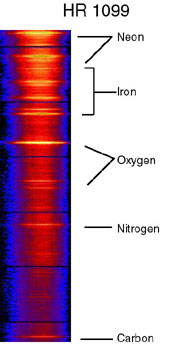
|
|
This image of the X-ray spectrum produced by HR 1099 taken by the Reflection Grating Spectrometer on the X-ray Multi-Mirror-Newton satellite and is the highest quality X-ray astrophysical spectrum ever obtained. HR 1099 is a system of two bright stars located a hundred light years away from the Earth in the constellation Taurus. The X-ray spectrum is a fingerprint of a plasma and can be used to determine the abundances of atoms, the temperature, and the physical conditions where the X-rays were produced.
|
A satellite carrying high-precision X-ray detectors designed and built by Columbia University astrophysicists opened its doors on January 25 and immediately provided scientists with the highest quality X-ray spectrum ever before gleaned from the universe.
Many celestial objects have temperatures too high to be seen in the visible range of light, but they emit energy levels that can be observed in the X-ray band. The Columbia researchers built an X-ray sensor so sensitive that it can detect millions of X-ray sources that were previously beyond the reach of modern science. With the satellite's launch and "first light" successfully completed, scientists will now be able to see how matter in the universe, usually gases from stars and dust, behaves when it gets pulled into the gravitational fields of very hot, high-density neutron stars and black holes -- objects that have been previously unobservable.
"The resolution is even better than we expected," said Steven Kahn, the chairman of Columbia's physics department and U.S. Principal Investigator on the project. "The spectrum is a fingerprint of the plasma swirling around a star, and with it we can determine the composition, abundance, temperature, and physical conditions where the X-rays were produced."
Columbia's two Reflection Grating Spectrometers on the X-ray Multi-mirror Mission-Newton satellite, known as the XMM-Newton, were pointed toward a pair of stars in the constellation Taurus, called HR1099, which rotate around each other at enormous speeds, causing their magnetic fields to twist and turn. It was chosen because it had already been observed by the Chandra satellite, a similar but less sensitive instrument, and the data could be compared to see if the XMM-Newton was performing well.
XMM-Newton's precision amazed Kahn and other leading astrophysicists, who were in the satellite's data control center in Villafranca, Spain.
"We immediately saw bright emission lines, which tell us about the composition of the gas," Kahn said. "We saw Oxygen, Neon, Iron, Carbon, and Nitrogen--fabulous new information because Chandra had never seen Carbon or Nitrogen in HR1099."
Kahn started the project in 1989 at the University of California at Berkeley, working with the Lawrence Livermore National Lab, but moved the research to Columbia when he joined the faculty in 1995. With his team of Columbia astrophysicists, including research scientists Frits Paerels and Andrew Rasmussen and graduate student Jean Cottam, he has received over $25 million from NASA to develop the X-ray technology needed for such a sensitive instrument. The design is intricate, with 200 thin gold plates that must be positioned so accurately that shifts of even one micron will affect the instrument's ability to assign wavelengths and colors to the X-ray radiation detected in outer space.
"One of our concerns was that the turbulence from the rocket launch would shift the instrument," said Kahn. "But we designed titanium flexures around it to absorb any shaking, and the instrument is working perfectly."
The XMM-Newton is a mission of the European Space Agency (ESA). The development of the Reflection Grating Spectrometer was a collaborative effort between research institutes in the Netherlands, Britain, Switzerland and the United States, with Columbia University leading the American effort. The satellite was launched on Dec. 10 from French Guiana, near the equator. The equatorial site is a requirement for the 48-hour orbit around the earth, which takes the satellite one quarter of the way to the moon. In addition to Columbia's two X-ray spectrometers, the satellite carries three X-ray imaging cameras and a 300mm-diameter optical monitoring telescope that for the first time allows simultaneous observation of the visible and near-infrared wavelengths. The whole machine weighs almost four tons and its solar panel "wingspan" measures more than 30 feet.
Scientists expect it to gather information for 10 years, although all hope it will be even longer.
More information and pictures are available at http://xmm.astro.columbia.edu and the News section of ESA's image gallery at http://www.esa.int.
|
